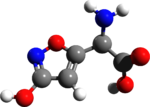Ibotenic acid
 |
|
 |
|
| Names | |
|---|---|
|
IUPAC name
(S)-2-amino-2-(3-hydroxyisoxazol-5-yl) acetic acid
|
|
| Other names
Ibotenic acid
|
|
| Identifiers | |
|
2552-55-8 |
|
| 3D model (Jmol) | Interactive image |
| ChEMBL |
ChEMBL284895 ChEMBL30285 |
| ChemSpider |
1196 |
| ECHA InfoCard | 100.151.170 |
| 1371 | |
| PubChem | 1233 |
|
|
|
|
| Properties | |
| C5H6N2O4 | |
| Molar mass | 158.11 g/mol |
| Melting point | 151-152° (anhydrous); 144-146° (monohydrate) |
| Solubility in Methanol | Soluble |
|
Except where otherwise noted, data are given for materials in their standard state (at 25 °C [77 °F], 100 kPa).
|
|
|
|
|
| Infobox references | |
Ibotenic acid or (S)-2-amino-2-(3-hydroxyisoxazol-5-yl) acetic acid, also referred to as ibotenate, is a chemical compound and psychoactive drug which occurs naturally in Amanita muscaria and related species of mushrooms typically found in the temperate and boreal regions of the northern hemisphere. It is a conformationally-restricted analogue of the neurotransmitter glutamate, and due to its structural similarity to this neurotransmitter, acts as a non-selective glutamate receptor agonist. Because of this, ibotenic acid can be a powerful neurotoxin, and is employed as a "brain-lesioning agent" in scientific research.
Ibotenic acid acts as a potent agonist of the NMDA and group I (mGluR1 and mGluR5) and II (mGluR2 and mGluR3) metabotropic glutamate receptors. It is inactive at group III mGluRs. Ibotenic acid also acts as a weak agonist of the AMPA and kainate receptors. In addition, due to in vivo decarboxylation into muscimol, it acts indirectly as a potent GABAA and GABAA-ρ receptor agonist. Unlike muscimol, the principal psychoactive constituent of Amanita muscaria that is understood to cause sedation and dissociation, ibotenic acid's psychoactive effects are not known independent of it serving as a prodrug to muscimol.
...
Wikipedia
